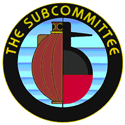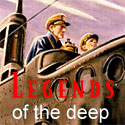
Tuesday, November 25, 2008
Testing, One, Two...

Monday, November 24, 2008
Back to Base-ics
 With the display base looking good, the urge to work on the boat came back so I returned to the wheelhouse. The pieces that were knocked off were CA'd back in place. Then I fabbed a latching pin system to keep it in place on the hull.
With the display base looking good, the urge to work on the boat came back so I returned to the wheelhouse. The pieces that were knocked off were CA'd back in place. Then I fabbed a latching pin system to keep it in place on the hull.
First, a hole was drilled in the forward end through both the deck and exterior pieces, then the forward access hatch in the hull. This captured a pin that slides in to secure them all via friction.

To hold the aft end in place a brass rod was bent to slide into a hole cut in the upper hull. This captures the entire assembly and holds it down. The wheelhouse now fits snug and doesn't move yet is capable of being disassembled. This will allow replacement of D-cell batteries for the lights inside the hull.
Friday, October 03, 2008
Prop Spin
A stainless 3/16" shaft was used along with a flange type oilite bronze bearing. With a wheel collar on the back side and some found pieces glued to the shaft on the outside to capture the shaft on the bearing, the bearing will be glued in place on the hull allowing the shaft to spin. The prop will be glued on the shaft once it is installed in the hull. Simple; easy; works.
Pics to come.
Friday, September 12, 2008
Atomized Phosphorus Anyone?

The primer was shot on the back side of the cans prior to assembly. I'll shoot the outboard side all at once at a later date.
Wednesday, September 10, 2008
On Guard!

Wednesday, September 03, 2008
An Accident...
The stair well cup was broken off along with the helm and control levers. Fortunately, each individual piece was virtually unharmed save for some scraped paint. The rails connecting the center stairwell pole to the circular railing were lost. And the helm railing was bent slightly. It was gently worked back into position.
So I set the parts aside after assessing the damage to redo the work again at a later date. For some reason I had a headache.
Thursday, August 28, 2008
Helm Rail
 Used the same procedure as before with a little rearrangement of the order. First, I used one half of a wooden clothespin as a form and bent the un-annealed brass wire into the proper shape. It was the perfect shape of the rail. I bent each end, one at a time, around the end of the clothespin. I cut the rectangle at the point where the rail went through the bottom leg of a support.
Used the same procedure as before with a little rearrangement of the order. First, I used one half of a wooden clothespin as a form and bent the un-annealed brass wire into the proper shape. It was the perfect shape of the rail. I bent each end, one at a time, around the end of the clothespin. I cut the rectangle at the point where the rail went through the bottom leg of a support. Next, I searched for the proper form for the curve of the rail. I measured it out and determined a cylinder with a 2.25" radius would work best. I finally found an air freshener spray can that fit the bill. Then, after annealing the wire to make it more malleable, I bent it around the can.
The supports slipped on one at a time at the joint in the wire. The upper supprt hole was strung on the wire and moved around until the lower hole lined up. It was slipped onto the wire then moved down. I arranged it so the break in the wire fit in the lower hole of a support. It was all secured with CA and the break in the wire is hardly visible.
I drilled two holes I marked in the deck for the proper placement of the supports and secured the assembly in place with two drops of 5 minute epoxy.

 With the railings completed, it's just a matter of gluing in the rest of the sub-assemblies such as the helm, control levers, depth tube, etc.
With the railings completed, it's just a matter of gluing in the rest of the sub-assemblies such as the helm, control levers, depth tube, etc.
Monday, August 25, 2008
So Long, Stair Well
The circular rails were made from .045 brass rod. I prepared them prior to bending via a process called annealing. I heated the brass with a small butane torch and then quenched them in water. This made the brass much more malleable than its original state. I bent it easily around a 1" wooden dowel. After drilling out the support pieces I threaded the rings through and CA'd them to the deck.
For the spiral staircase well the CR instructions recommend a 1" id clear acrylic tube. I couldn't find one in the local hobby shops or hardware stores so I opted for the next best thing: a 1 1/4" PVC end cap. I sprayed the interior flat black, drilled a hole in the bottom for the brass rod center support and glued it to the underside of the deck with 5-minute epoxy.
 As an side, I'm really getting used to the quick cure epoxy -- apart from the smell. It sets up fast with a strong bond. For static builds it's great. I realize now how prejudiced against it my r/c past had made me -- 5-minute epoxy not being waterproof. But I'm using it more and more as I go.
As an side, I'm really getting used to the quick cure epoxy -- apart from the smell. It sets up fast with a strong bond. For static builds it's great. I realize now how prejudiced against it my r/c past had made me -- 5-minute epoxy not being waterproof. But I'm using it more and more as I go.
The rails were completed with two sections connecting the rings to the center pole. CR recommends a 1/8" diameter rod for the pole. But to me it looked too thick so I traded down a size or two.
The ball on top of the pole is a 4mm gold bead from the fabric store. I filled the center with a small length of brass rod. I left the center pole in unpolished brass, along with the rails. I think it looks better (the pole and stairs were painted in the movie). I brushed the white metal rail supports with gold enamel.
I've got to say this step was one of the most tedious of the build. And super close images show where the rails and supports are out of alignment. However, with the wheelhouse covering it the flaws will be very difficult to see through the windows. I'm satisfied with the look.
Wednesday, August 20, 2008
In Praise of Beginner Subs
 Had a conversation with a new member of the r/c sub community last week and it brought to mind the central issue for the newbie: what to build first?
Had a conversation with a new member of the r/c sub community last week and it brought to mind the central issue for the newbie: what to build first?Most of us are drawn to the hobby with visions of grandeur swimming in our heads. For me it was the ultimate fleet boat: 1/32 scale; fully detailed down to the last rivet; operational masts and radar; ten working torpedo tubes; diesel sounds when on the surface; running lights. I actually found a 32nd Parallel hull. It sat on my dining room table for a few weeks, hanging over each end by several feet, before it hit me -- I can't do this.
So many of my fellow skippers experienced the same crossroads starting out. The boat of their dreams was beyond their earthly means. What separated the ones who continue on in the hobby and those who don't? The "Beginner Sub."
The beginner sub is large enough to run in open water (Wal-Mart subs are toys). They come almost ready to run (Small World Model's boats), or in a highly prefabricated kit form (SubTech Albacore, Dumas Akula, ThorDesign Permit). Either way the box includes detailed instructions. Note that "beginner" doesn't mean "cheap." These are real r/c subs that stand up under use and perform like their real world counterparts. In most cases, Dumas Akula excluded, they are highly accurate scale models.
But why waste time building a boat you don't lay awake at night dreaming about? Simple. Instead of dreaming you will actually be driving, sooner rather than never. A beginner boat teaches you the things you don't yet know you need to know. Things like the fact that 5 minute epoxy isn't waterproof; how to install a WTC so that it sits level in the hull; setting up stern plane linkages around a prop shaft.
What the new guy can't know is that building the scale representation of a submarine is only one aspect of r/c submarining. You've also got to master submarine-specific electronics and how to keep them dry while in use. Trimming is an additional art that only comes through patient trial and error. The skill with which it is done means the difference between a pig of a boat or a sub that dances to your command. Because it takes skill to get r/c subs to run the way they were born to. Skill that can only be gained by stick time.
That's what beginner subs boil down to when laid alongside the jaw dropping museum pieces of our imaginations: they get completed in a reasonable amount of time and they run. They don't have to be perfectly within scale, they don't even have to look particularly pretty. They just need to be ready to run when the call comes down to go to the pond. Because r/c submarines are way more fun to drive than watch being driven.
And once your beginner sub is done you'll have plenty of time and space to tinker with your large scale Disney Nautilus project. They're what work benches are for.
Tuesday, August 05, 2008
SubRegatta 2008
Thursday, July 10, 2008
Sun N Fun 2008
Due to lack of luggage space I chose to take only my 1/96 USS Thresher. In order to get it running I basically restored the 12 year old WTC which I had disassembled last summer due to leaking.
While the WTC went back together well, the electronics gave me fits. A Viper 10 amp mini speed control was new to the mix and every time I tried to fire the system up it showed a signal error. I would take it apart, check the connections, spread everything across the bench, and it would finally work. Then, once reinstalled in the WTC, the same error would occur: no transmitter signal received by the receiver. I finally gave up and threw it all in the car for the trip.
When it came time to run on Friday I buttoned things up and flipped on the system -- and it worked like a champ! I got three extended runs over two days without a glitch. It felt great to have a working boat in the water. All I can deduce is there must be some sort of significant interference at my home which is confounding my radio on the bench.
The new speed control worked well but really advances the speed with minimal clicks of the throttle control. Once underway, I resorted to controlling the boat with trim tabs. Below are a few images of Thresher underway at the event:


Monday, May 26, 2008
1/72 Permit class build
This weekend I got to put in some shop time. Having been down this road before with a ThorDesign Permit I plowed through a z-cut, the indexing lips, MBT floods, installing and truing up the sail, and mounting the bearings for the stern appendages. The stern planes are not installed permanently quite yet -- I'm still fine tuning the fit. Overall it was a pretty eventful weekend.



 Been also doing research on the class to decide which boat to build. Along the way I was fortunate enough to strike up a conversation with a former CO of USS Guardfish (SSN-612). As a result I've settled on depicting his boat as it was in the summer of '72 when she famously trailed an Echo II from Russia to Viet Nam.
Been also doing research on the class to decide which boat to build. Along the way I was fortunate enough to strike up a conversation with a former CO of USS Guardfish (SSN-612). As a result I've settled on depicting his boat as it was in the summer of '72 when she famously trailed an Echo II from Russia to Viet Nam.









